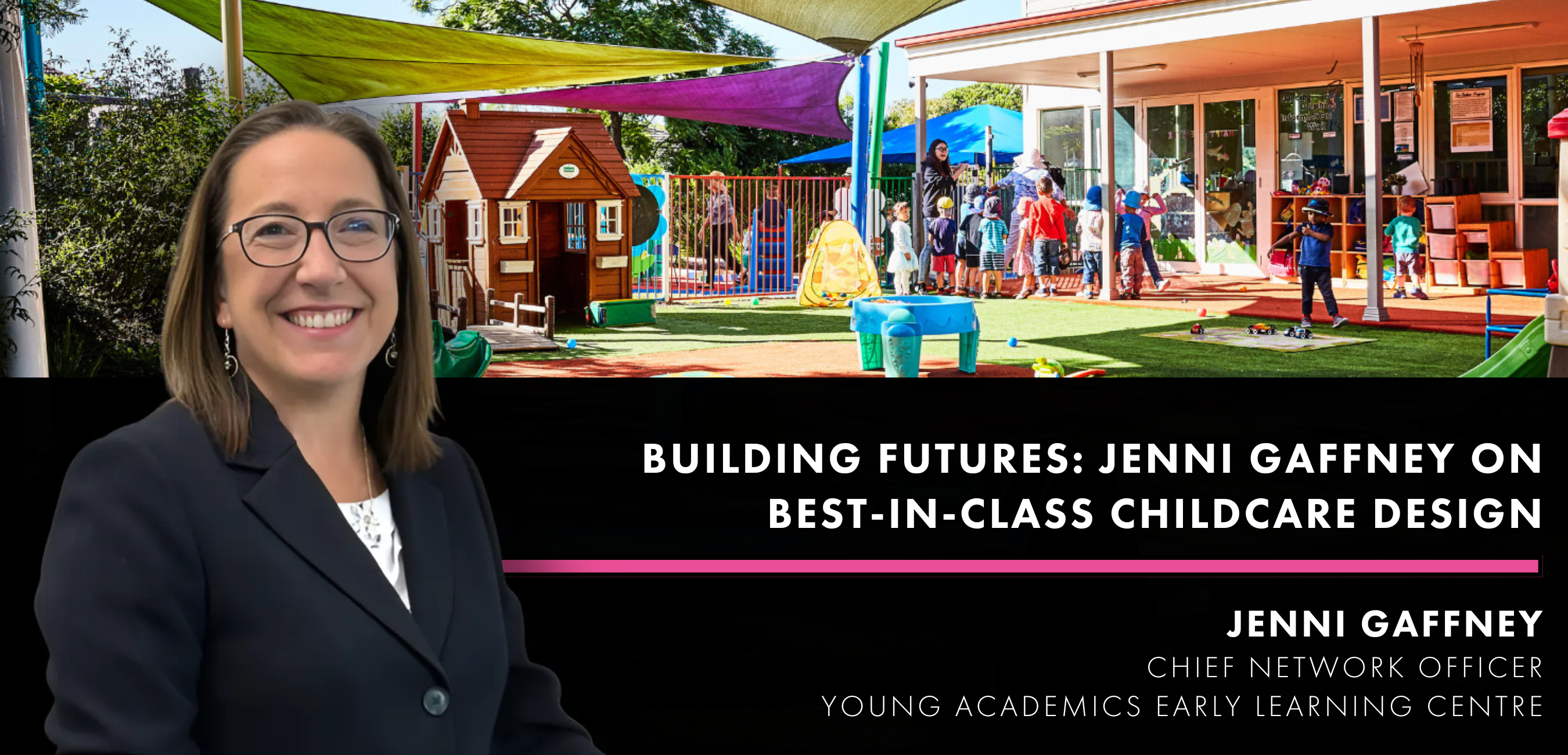Designing childcare centres that nurture both learning and operational excellence is no small feat. In this exclusive interview, Jenni Gaffney, a seasoned expert in early childhood education, shares her insights on creating environments that foster development and efficiency. From innovative classroom designs to the integration of technology, Jenni delves into the elements that make a centre both functional and inspiring. She also discusses the importance of collaboration among architects, developers, and operators, and how aligning these stakeholders can lead to optimal outcomes. Read on to discover Jenni’s perspectives on overcoming regulatory challenges, embracing technological advancements, and the key factors that define best-in-class centre design.
FuturePlace: Designing a childcare centre isn’t just about aesthetics – it directly impacts learning outcomes and operational efficiency. What key design elements do you believe make a centre both functional and engaging for children and staff?
Jenni Gaffney: Each classroom should have direct access from a corridor. While this may sound straightforward, it is not always the case. Direct access from the corridor prevents disruptions that occur when parents need to walk through one classroom to access another, which can interfere with children’s learning and unsettle younger children.
Classrooms should be adaptable, with layouts that can easily accommodate small groups of children. This flexibility enhances classroom management and supports diverse learning activities. Proper acoustic treatment in the flooring and ceiling is essential to reduce noise levels. This helps improve concentration, engagement, and overall learning, benefiting both children and educators.
Futureplace: The relationship between architects, developers, and operators is crucial in bringing a successful centre to life. What do you think are the most important factors for ensuring collaboration leads to the best outcomes?
Jenni Gaffney: Open, ongoing dialogue throughout the design and development process ensures that everyone is aligned with the vision, goals, and constraints. Regular meetings, site visits, and updates help address challenges early and keep the project on track. It is crucial for all parties to have a shared understanding of the non-negotiables – whether they are design requirements, budget limits, or operational needs – and to work collaboratively to find solutions that meet these essential criteria. Each party brings valuable knowledge to the table: architects are experts in design and functionality, developers understand budgets and timelines, and operators know what works in day-to-day operations. These factors foster a collaborative environment that ensures the project meets both design standards and operational needs, leading to optimal outcomes.
FuturePlace: Regulations and compliance standards play a significant role in centre design and operations. What are some of the biggest design-related challenges operators face when meeting regulatory requirements, and how can they be overcome?
Jenni Gaffney: One of the biggest design-related challenges operators face today is the conflict between new fire compliance standards and the need to maintain clear sightlines between classrooms, bathrooms, and corridors. The addition of fire-resistant walls, combined with restrictions on adding viewing windows in some walls, not only affects supervision but also reduces natural lighting and impacts the aesthetics of the space. It is becoming increasingly difficult for centres to access their outdoor spaces due to child limits and time restrictions imposed by the AAAC guidelines. The limitation of just four hours a day for the entire cohort of children significantly reduces their access to both the outdoor environment and the curriculum.
FuturePlace: At the Childcare & Early Learning Real Estate Summit, you will participate in a discussion on best-in-class centre design. What key insights can attendees expect from this session?
Jenni Gaffney: For me, ‘best-in-class design’ revolves around the functional aspects that enable operators to create high-quality environments supporting children’s development. Key factors include thoughtful room layouts with ample storage, appropriately sized classrooms, easy access to amenities, and the ability to seamlessly run both indoor and outdoor programs simultaneously. These elements can significantly enhance program outcomes. For a 150-place centre, best-in-class design ensures that each individual classroom feels like its own distinct centre, fostering a sense of community and individualised care.
FuturePlace: Technology is increasingly integrated into childcare centres, from security systems to learning tools. How do you see technology shaping the future of centre design and daily operations?
Jenni Gaffney: Technology plays an increasing role in childcare centre design, especially concerning learning tools, communication platforms, and security systems. These advancements help improve efficiency, streamline administrative tasks, and enhance safety. As technology continues to evolve, we will see more interactive learning tools incorporated into classrooms and outdoor spaces, making it easier for children to engage with educational content innovatively. Similarly, systems for managing staff and resources will be essential for the smooth operation of centres.
FuturePlace: The summit brings together developers, investors, and operators to discuss the future of childcare real estate. Why is it important for all these stakeholders to align when designing and operating new centres?
Jenni Gaffney: Aligning all stakeholders when designing and operating new centres is crucial to ensure both operational efficiency and a design that is fit for purpose. A one-size-fits-all approach does not always work for every operator. For example, I prioritise including respectful and spacious staff amenities in the design, whereas, in some cases, these areas are reduced to maximise the centre’s licence capacity. Our staff are valuable assets to our organisation, and providing them with a light, bright, and spacious area to rest is important to me as an operator.
FuturePlace: Finally, for anyone considering the Childcare and Early Learning Real Estate Summit, what would you say are the biggest reasons to be part of the discussion and attend the event?
Jenni Gaffney: Attendees will gain valuable insights from experts on the latest trends in childcare and early learning real estate. Understanding market shifts, regulatory changes, and emerging design trends can help participants stay ahead in this dynamic industry. Building relationships at the summit can open doors to new partnerships, collaborations, and business opportunities. The summit offers a unique opportunity to hear from thought leaders and ask questions that are important to you.
Jenni Gaffney, Chief Network Officer at Young Academics, will join industry leaders Andrew Daly, Director of Supercontext; Sherif Saad, Director of ArtMade Architects; and David Klingberg, Director of Smart Planning and Design, in the panel discussion “Innovative Practices in Design and Construction Creating the Next Generation of Childcare Facilities.” Facilitated by Troy Owen, Director at ON Architecture, this session is part of the Childcare & Early Learning Real Estate Summit. Taking place on 7th-8th May 2025, at Doltone House in Sydney, the summit convenes over 250 industry leaders – including operators, developers, investors, and suppliers – to explore advancements in the childcare real estate sector. Learn more and register at childcarerealestatesummit.com.

Jenni Gaffney
Chief Network Officer, Young Academics Early Learning Centre





